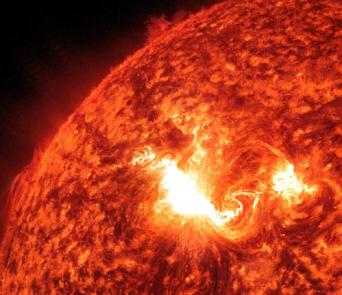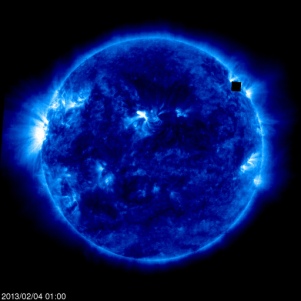
A strong solar flare (X5) captured by NASA’s Solar Dynamics Observatory (SDO) in March 2012. Solar flares can but don’t always lead to CMEs
What happens on the sun can have far-reaching effects here on earth. Most famously, large coronal mass ejections (CMEs), gaseous explosions on the surface of the sun, if directed at earth, can have dire consequences for modern communications systems and electric infrastructure by generating excess current that can fry space satellites and overload transformers in a domino like fashion. The results can be disastrous. Perhaps for this reason, a growing community of hobby scientists and astronomers keeps a close daily watch on the data that spaceships and satellites send back about our sun, as developments in the recent decade have made it possible to view the sun, and its emissions, in near real time.
A series of CMEs in September 1859 serves as the most dramatic example of solar interference in what came to be known as the Carrington Event. Two extremely large CMEs downed communications as telegraphers failed and transmission lines sent sparks into the air, fried from electric overcharge. Global communications came to a screeching halt as telegraphing systems were completely incapacitated, leaving equipment permanently damaged.
Today we are even more vulnerable to large CMEs than we were in 1859. In past decades, CMEs that were about a quarter of the magnitude of the Carrington Event have caused significant interruptions. During the Quebec Blackout in 1989, the entire Quebec hydropower system went down within 90 seconds of a CME reaching earth, leaving millions of people without electricity for 9 hours. Power transformers as far south as in New Jersey were damaged beyond repair, taking months to replace. Similarly, in 2003, the city of Malmo in Sweden experienced a power outage because a CME induced a current overloaded of a high-voltage transformer. In addition, space satellites malfunctioned and radio signals were interfered.
Luckily, these events were only a fraction of the solar storm experienced during the Carrington Event. What has changed is that today virtually all aspects of our infrastructure depend on electricity and electrical systems. If another Carrington-type event were to occur, satellite systems would stop working. This means GPS and credit card transactions would be out of commission, possibly for long periods. Most importantly, transformers that support global energy networks could fail at great numbers—taking years to replace and possibly leaving entire regions starved for power for not only months but years.
NASA estimates damages could reach US$ 10 trillion with repairs on power systems lasting a decade—and more. A detailed discussion of potential threats from a solar storm is provided by James Marusek
Although our sun is a constant presence in our lives, we don’t know much about it. There are some indications that may help us predict short term events such as CMEs that may have an impact here on earth. Typically, we can tell about 1-3 days before a CME arrives, but even though we are able to tell the signs that may lead to large CMEs and solar storms, we know overwhelmingly little about sun’s behavior, especially over longer time frames.

SoHO provides real-time images of the sun. This one was taken on February 4th, 2013 using an Extreme ultraviolet Imaging Telescope. Taken at 171 Angstrom, this image best shows areas of low temperature (1 million K).
Many of the systems to monitor the sun have been in use only for a few decades, often less. SOHO (Solar and Heliosphereic Observatory) was launched in 1995, STEREO (Solar Terrestrial Relations Observatory) in 2006, and SDO (Solar Dynamics Observatory) in 2010. Attempts at predicting the likelihood of another Carrington-scale CME happening in the near future are based on proxies and assumptions that render estimates—at best—highly questionable. Schrijver et al estimates in a 2012 paper published in Space Physics that a Carrington-type event within the next decades is very unlikely. At the same time, a paper by Riley, P. estimates this chance at 12% within the next decade.
Scientists and hobby astronomers are now working hard to make up for the lack of knowledge about the sun. In fact, this field is still relatively new and discoveries about the sun are made frequently, often by amateur astronomers. In order to deal with the deluge of data that is coming in, the Greenwich Observatory has appealed to the public to help spot explosions on the sun in a project called Solar Stormwatch. Public engagement will not only help make sense of the data that is coming from the sun, but more importantly make it possible to spot early warning signs of potential solar events that may affect earth.
Links:
On estimating the risk of a Carrington-type CME hitting earth again
Schrijver, C. J. et al. Estimating the frequency of extremely energetic solar events, based on solar, stellar, lunar, and terrestrial records. Journal of Geophysical Research: Space Physics 117, n/a–n/a (2012). http://onlinelibrary.wiley.com/doi/10.1029/2012JA017706/abstract
Riley, P. On the probability of occurrence of extreme space weather events. Space Weather 10, 02012 (2012). http://adsabs.harvard.edu/abs/2012SpWea..1002012R
Other great resources to help understand our sun:
Eddy, J. A. (1976). The maunder minimum. Science, 192(4245), 1189-1202. http://ftp.issibern.ch/teams/Variable/Referencepapers/EddyScience1976.pdf
Potential effects of a major CME:
Committee on the Societal and Economic Impacts of Severe Space Weather Events: A Workshop, National Research Council Severe Space Weather Events–Understanding Societal and Economic Impacts:A Workshop Report. (The National Academies Press, 2008). http://books.nap.edu/catalog.php?record_id=12507